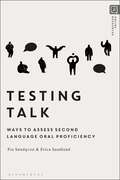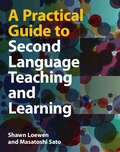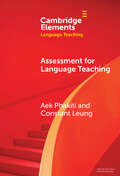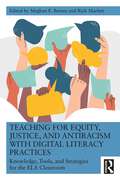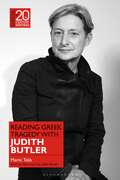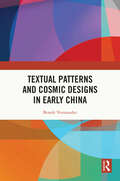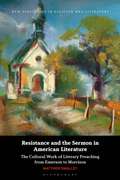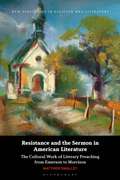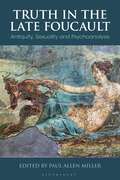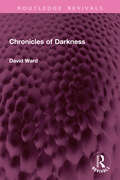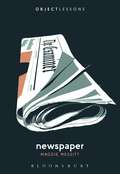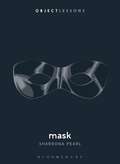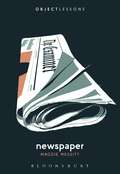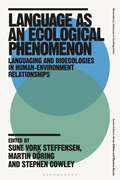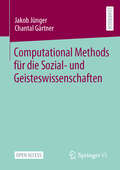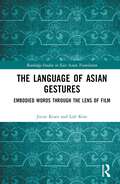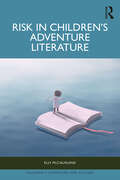- Table View
- List View
Testing Talk: Ways to Assess Second Language Oral Proficiency
by Dr Pia Sundqvist Dr Erica SandlundOral assessments are of vital importance to second language learners, but how can teachers and examiners best test L2 learner talk and interaction? Bringing together theory and research within the field of L2 oral proficiency, with the concept of L2 encompassing any language learned later than the early childhood years, this book provides a state-of-the art overview of what is at stake for L2 learners and examiners, and advice on how to approach testing and assessment. Using data and findings from empirical research to illustrate and discuss key topics, Testing Talk takes the reader step-by-step through the major concepts and issues in the oral assessment of second languages, with a main focus on L2 English. Investigating and explaining the most important educational and interactional issues facing both examiners and test-takers, such as the factors which come into play during speaking tests, the differences between common test formats, and the challenge of ensuring equity in assessment, this book offers research-based advice on ways to design test tasks and in-depth insights into the assessment of L2 speaking. Featuring a glossary of key terms and concepts, discussion questions and further reading for each chapter, and a comprehensive companion website hosting a wealth of additional materials, including authentic test recordings and assessment tasks to be used by researchers and practitioners alike, this is the only book needed in order to understand, design, and assess interactive oral L2 tests.
Testing Talk: Ways to Assess Second Language Oral Proficiency
by Dr Pia Sundqvist Dr Erica SandlundOral assessments are of vital importance to second language learners, but how can teachers and examiners best test L2 learner talk and interaction? Bringing together theory and research within the field of L2 oral proficiency, with the concept of L2 encompassing any language learned later than the early childhood years, this book provides a state-of-the art overview of what is at stake for L2 learners and examiners, and advice on how to approach testing and assessment. Using data and findings from empirical research to illustrate and discuss key topics, Testing Talk takes the reader step-by-step through the major concepts and issues in the oral assessment of second languages, with a main focus on L2 English. Investigating and explaining the most important educational and interactional issues facing both examiners and test-takers, such as the factors which come into play during speaking tests, the differences between common test formats, and the challenge of ensuring equity in assessment, this book offers research-based advice on ways to design test tasks and in-depth insights into the assessment of L2 speaking. Featuring a glossary of key terms and concepts, discussion questions and further reading for each chapter, and a comprehensive companion website hosting a wealth of additional materials, including authentic test recordings and assessment tasks to be used by researchers and practitioners alike, this is the only book needed in order to understand, design, and assess interactive oral L2 tests.
A Practical Guide to Second Language Teaching and Learning
by null Shawn Loewen null Masatoshi SatoAn essential resource for individuals entering the field of second language (L2) teaching and learning, this book provides a complete set of instructional materials written in accessible language. Providing enough material to use for an entire semester, the book offers exciting activities for the L2 classroom, alongside outlining the theories and research that support them, including how to connect theory with practice. Each chapter includes: extensive and up-to-date content presented in a clear, engaging, and accessible manner; pre- and post-reading activities to help students connect the topics to their own lives; pedagogical guidelines with practical suggestions; summaries of empirical studies in non-technical, jargon-free language; end-of-chapter assignments which re-enforce students' learning and relate directly to the content. The book concludes with a compelling chapter on the research–practice dialogue. Online resources include lecture slides for instructors and audio files.
Assessment for Language Teaching (Elements in Language Teaching)
by null Aek Phakiti null Constant LeungThis Element reviews the key foundational concepts, beliefs, and practices underpinning approaches to assessment in English Language Teaching. Exploring major concepts and practices through educational, social, and ethical perspectives, it offers theoretically informed and close-to-practice descriptions and up-to-date explanations of the affordances and limitations of different assessment approaches related to language teaching. This Element presents a cohesive and pragmatic framework that allows teachers to efficiently implement tests and assessments in their contexts.
Teaching for Equity, Justice, and Antiracism with Digital Literacy Practices: Knowledge, Tools, and Strategies for the ELA Classroom
by Meghan E. Barnes Rick MarlattTo embrace today’s culturally and linguistically diverse secondary English Language Arts (ELA) classrooms, this text presents ways in which teachers can use digital tools in the service of antiracist teaching and developing equity-oriented mindsets in teaching and learning.Addressing how the use of digital tools and literacy practices can be woven into current ELA curricula, and with consistent sections, each chapter covers a different aspect of digital tool use, including multimodal texts, critical media literacies, connection-building, and digital composing. Understanding that no classroom is a monolith, Barnes and Marlatt’s timely text presents practical applications and resources suitable for different environments, including urban and rural contexts.The volume is essential reading in courses on ELA/literacy methods and multicultural education.
Teaching for Equity, Justice, and Antiracism with Digital Literacy Practices: Knowledge, Tools, and Strategies for the ELA Classroom
by Meghan E. Barnes Rick MarlattTo embrace today’s culturally and linguistically diverse secondary English Language Arts (ELA) classrooms, this text presents ways in which teachers can use digital tools in the service of antiracist teaching and developing equity-oriented mindsets in teaching and learning.Addressing how the use of digital tools and literacy practices can be woven into current ELA curricula, and with consistent sections, each chapter covers a different aspect of digital tool use, including multimodal texts, critical media literacies, connection-building, and digital composing. Understanding that no classroom is a monolith, Barnes and Marlatt’s timely text presents practical applications and resources suitable for different environments, including urban and rural contexts.The volume is essential reading in courses on ELA/literacy methods and multicultural education.
Reading Greek Tragedy with Judith Butler (Classical Receptions in Twentieth-Century Writing)
by Professor Mario TelòConsidering Butler's “tragic trilogy”-a set of interventions on Sophocles' Antigone, Euripides' Bacchae, and Aeschylus's Eumenides-this book seeks to understand not just how Butler uses and interprets Greek tragedy, but also how tragedy shapes Butler's thinking, even when their gaze is directed elsewhere. Through close readings of these tragedies, this book brings to light the tragic quality of Butler's writing. It shows how Butler's mode of reading tragedy-and, crucially, reading tragically-offers a distinctive ethico-political response to the harrowing dilemmas of our current moment. Deeply committed both to critical theory and political activism, Judith Butler is one of the most influential intellectuals today. Their ideas have touched the lives of many people, both readers and those who have never heard Butler's name. In encompassing gender performativity and sexual difference, vulnerability and precarity, disidentification and bodily interdependency, as well as the politics of protest, Butler's work is often predicated on a strong engagement with or proximity to Greek tragedy.
Reading Greek Tragedy with Judith Butler (Classical Receptions in Twentieth-Century Writing)
by Professor Mario TelòConsidering Butler's “tragic trilogy”-a set of interventions on Sophocles' Antigone, Euripides' Bacchae, and Aeschylus's Eumenides-this book seeks to understand not just how Butler uses and interprets Greek tragedy, but also how tragedy shapes Butler's thinking, even when their gaze is directed elsewhere. Through close readings of these tragedies, this book brings to light the tragic quality of Butler's writing. It shows how Butler's mode of reading tragedy-and, crucially, reading tragically-offers a distinctive ethico-political response to the harrowing dilemmas of our current moment. Deeply committed both to critical theory and political activism, Judith Butler is one of the most influential intellectuals today. Their ideas have touched the lives of many people, both readers and those who have never heard Butler's name. In encompassing gender performativity and sexual difference, vulnerability and precarity, disidentification and bodily interdependency, as well as the politics of protest, Butler's work is often predicated on a strong engagement with or proximity to Greek tragedy.
Textual Patterns and Cosmic Designs in Early China
by Benoît VermanderVia a hermeneutics focused on Chinese numerology and concentric arrangements, this book offers a novel construal of the textual universe proper to early China writings.The author lays bare distinguishable patterns of textual composition while relating them to corresponding patterns of thinking. He differentiates rhetorical variants through detailed studies of the Zhuangzi’s Inner chapters, the Laozi, the Analects, and the Huainanzi. The philosophical depth and relevance of the Chinese ancient worldview appear in a fresh light when one unearths the patterns into which its content is embedded. The focus on textual patterns and rhetorical arrangements also facilitates the reading of Chinese classics alongside other traditions.The book will be a valuable reference for scholars and graduate students studying Chinese literary criticism, Chinese philosophy, and comparative philosophy.
Textual Patterns and Cosmic Designs in Early China
by Benoît VermanderVia a hermeneutics focused on Chinese numerology and concentric arrangements, this book offers a novel construal of the textual universe proper to early China writings.The author lays bare distinguishable patterns of textual composition while relating them to corresponding patterns of thinking. He differentiates rhetorical variants through detailed studies of the Zhuangzi’s Inner chapters, the Laozi, the Analects, and the Huainanzi. The philosophical depth and relevance of the Chinese ancient worldview appear in a fresh light when one unearths the patterns into which its content is embedded. The focus on textual patterns and rhetorical arrangements also facilitates the reading of Chinese classics alongside other traditions.The book will be a valuable reference for scholars and graduate students studying Chinese literary criticism, Chinese philosophy, and comparative philosophy.
Resistance and the Sermon in American Literature: The Cultural Work of Literary Preaching from Emerson to Morrison (New Directions in Religion and Literature)
by Matthew SmalleyWith seemingly obsessive regularity, American authors, from the mid-nineteenth century to the present, evoke the sermon at culturally loaded moments in their works, deploying the form to underscore the cultural work they imagine their novels or poetry to perform. Examining this longstanding tradition of “literary preaching,” this book draws on literary applications of design theory to provide a nuanced account of American literature's complex, anxious, and persistent engagement with the Protestant sermon. Analyzing literary preaching as a transhistorical form that simultaneously attracts and repels authors, Smalley demonstrates how major US writers–Ralph Waldo Emerson, Walt Whitman, Nathaniel Hawthorne, Rebecca Harding Davis, William Faulkner, Zora Neale Hurston, and Toni Morrison–have subverted the sermon's predominantly religious content in order to reimagine profound moments of reform in a political, cultural, and aesthetic mode. This study elucidates new lines of literary kinship, offers fresh readings of familiar works, and establishes literary preaching as an undertheorized but significant tradition in American literature.
Resistance and the Sermon in American Literature: The Cultural Work of Literary Preaching from Emerson to Morrison (New Directions in Religion and Literature)
by Matthew SmalleyWith seemingly obsessive regularity, American authors, from the mid-nineteenth century to the present, evoke the sermon at culturally loaded moments in their works, deploying the form to underscore the cultural work they imagine their novels or poetry to perform. Examining this longstanding tradition of “literary preaching,” this book draws on literary applications of design theory to provide a nuanced account of American literature's complex, anxious, and persistent engagement with the Protestant sermon. Analyzing literary preaching as a transhistorical form that simultaneously attracts and repels authors, Smalley demonstrates how major US writers–Ralph Waldo Emerson, Walt Whitman, Nathaniel Hawthorne, Rebecca Harding Davis, William Faulkner, Zora Neale Hurston, and Toni Morrison–have subverted the sermon's predominantly religious content in order to reimagine profound moments of reform in a political, cultural, and aesthetic mode. This study elucidates new lines of literary kinship, offers fresh readings of familiar works, and establishes literary preaching as an undertheorized but significant tradition in American literature.
Truth in the Late Foucault: Antiquity, Sexuality, and Psychoanalysis (Bloomsbury Studies in Classical Reception)
by Paul Allen MillerThe first full treatment of truth as a core philosophical concept in the late Foucault, this volume examines his work on the ancient world and the early church. Each essay features a deep examination as to how the topics of truth and sexuality intersect with and focus on Foucault's engagement with ancient philosophy and thought. Truth in the Late Foucault offers readings on Plato, Artemidorus, Cicero, Sophocles and the Stoics, and pays close attention to Cassian, Paulinus of Nola, and early Christian practices of confession. With the publication of the long-awaited volume 4 of the History of Sexuality: Confessions of the Flesh, the shape of the final Foucault is now brought into stark relief. As well as looking at ancient thought, the contributors explore Foucault's work in relation to philosophers such as Gadamer, Heidegger, Derrida and Descartes. Foucault's long-running and often contentious dialogue with psychoanalysis, on the relation between truth and the subject, is also examined. Each essay not only makes an important statement, but also is part of an interconnected arc of topics and understanding, covering both the ancient and modern periods. This book reveals that Foucault's concern with antiquity raises questions deeply pertinent to the present moment.
Chronicles of Darkness (Routledge Revivals)
by David WardFirst published in 1989, Chronicles of Darkness is about images of Africa seen through the eyes of writers, visitors, residents, and native-born. They range from Joseph Conrad and Olive Schreiner, through Laurens van der Post, Karen Blixen and Evelyn Waugh, to more recent writers like Nadine Gordimer, Andre Brink and J.M. Coetzee.Such writers have frequently been faced with feelings of alienation, marginality, exile, self-consciousness, and egoism. It is only in this sense- that the eyes which see are shadowed and troubled- that Africa is a ‘dark continent’ and that these writings are ‘chronicles of darkness’. In some cases, Africa, even if merely a backdrop painted in crude and garish colors, becomes a way of revealing or admitting something about ‘Europe’ which might be concealed when a writer performs in a different theatre. This is an interesting read for scholars and researchers of English literature and African studies.
Chronicles of Darkness (Routledge Revivals)
by David WardFirst published in 1989, Chronicles of Darkness is about images of Africa seen through the eyes of writers, visitors, residents, and native-born. They range from Joseph Conrad and Olive Schreiner, through Laurens van der Post, Karen Blixen and Evelyn Waugh, to more recent writers like Nadine Gordimer, Andre Brink and J.M. Coetzee.Such writers have frequently been faced with feelings of alienation, marginality, exile, self-consciousness, and egoism. It is only in this sense- that the eyes which see are shadowed and troubled- that Africa is a ‘dark continent’ and that these writings are ‘chronicles of darkness’. In some cases, Africa, even if merely a backdrop painted in crude and garish colors, becomes a way of revealing or admitting something about ‘Europe’ which might be concealed when a writer performs in a different theatre. This is an interesting read for scholars and researchers of English literature and African studies.
Truth in the Late Foucault: Antiquity, Sexuality, and Psychoanalysis (Bloomsbury Studies in Classical Reception)
The first full treatment of truth as a core philosophical concept in the late Foucault, this volume examines his work on the ancient world and the early church. Each essay features a deep examination as to how the topics of truth and sexuality intersect with and focus on Foucault's engagement with ancient philosophy and thought. Truth in the Late Foucault offers readings on Plato, Artemidorus, Cicero, Sophocles and the Stoics, and pays close attention to Cassian, Paulinus of Nola, and early Christian practices of confession. With the publication of the long-awaited volume 4 of the History of Sexuality: Confessions of the Flesh, the shape of the final Foucault is now brought into stark relief. As well as looking at ancient thought, the contributors explore Foucault's work in relation to philosophers such as Gadamer, Heidegger, Derrida and Descartes. Foucault's long-running and often contentious dialogue with psychoanalysis, on the relation between truth and the subject, is also examined. Each essay not only makes an important statement, but also is part of an interconnected arc of topics and understanding, covering both the ancient and modern periods. This book reveals that Foucault's concern with antiquity raises questions deeply pertinent to the present moment.
Newspaper (Object Lessons)
by Dr. Maggie MessittObject Lessons is a series of short, beautifully designed books about the hidden lives of ordinary things.Newspaper is about more than news printed on paper. It brings us inside our best and worst selves, from censorship and the intentional destruction of historic record, to partisan and white supremacist campaigns, to the story of an instrument that has been central to democracy and to holding the powerful to account. This is a 400-year history of a nearly-endangered object as seen by journalist Maggie Messitt in the two democratic nations she calls home – the United States and South Africa.The “first draft of history,” newspapers figure prominently through each movement and period of unrest in both nations-from the first colonial papers published by slave traders and an advocate for press freedom to those published on id cards, wallpaper, and folio sheets during civil wars. Offices were set on fire. Presses were pushed into bodies of water. Editors were run out of town. And journalists were arrested.Newspaper reflects on a tool that has been used to push down and to rise up, and a journey alongside the hidden lives that have harnessed its power.Object Lessons is published in partnership with an essay series in The Atlantic.
Mask (Object Lessons)
by Dr. Sharrona PearlObject Lessons is a series of short, beautifully designed books about the hidden lives of ordinary things.From the theater mask and masquerade to the masked criminal and the rise of facial recognition software, masks have long performed as an instrument for the protection and concealment of identity. Even as they conceal and protect, masks – as faces – are an extension of the self. At the same time, they are a part of material culture: what are masks made of? What traces do they leave behind? Acknowledging that that mask-wearing has become increasingly weaponized and politicized, Sharrona Pearl looks at the politics of the mask, exploring how identity itself is read on this object.By exploring who we do (and do not) seek to protect through different forms of masking, Sharrona Pearl's long history of masks helps us to better understand what it is we value. Object Lessons is published in partnership with an essay series in The Atlantic.
Newspaper (Object Lessons)
by Dr. Maggie MessittObject Lessons is a series of short, beautifully designed books about the hidden lives of ordinary things.Newspaper is about more than news printed on paper. It brings us inside our best and worst selves, from censorship and the intentional destruction of historic record, to partisan and white supremacist campaigns, to the story of an instrument that has been central to democracy and to holding the powerful to account. This is a 400-year history of a nearly-endangered object as seen by journalist Maggie Messitt in the two democratic nations she calls home – the United States and South Africa.The “first draft of history,” newspapers figure prominently through each movement and period of unrest in both nations-from the first colonial papers published by slave traders and an advocate for press freedom to those published on id cards, wallpaper, and folio sheets during civil wars. Offices were set on fire. Presses were pushed into bodies of water. Editors were run out of town. And journalists were arrested.Newspaper reflects on a tool that has been used to push down and to rise up, and a journey alongside the hidden lives that have harnessed its power.Object Lessons is published in partnership with an essay series in The Atlantic.
Mask (Object Lessons)
by Dr. Sharrona PearlObject Lessons is a series of short, beautifully designed books about the hidden lives of ordinary things.From the theater mask and masquerade to the masked criminal and the rise of facial recognition software, masks have long performed as an instrument for the protection and concealment of identity. Even as they conceal and protect, masks – as faces – are an extension of the self. At the same time, they are a part of material culture: what are masks made of? What traces do they leave behind? Acknowledging that that mask-wearing has become increasingly weaponized and politicized, Sharrona Pearl looks at the politics of the mask, exploring how identity itself is read on this object.By exploring who we do (and do not) seek to protect through different forms of masking, Sharrona Pearl's long history of masks helps us to better understand what it is we value. Object Lessons is published in partnership with an essay series in The Atlantic.
Language as an Ecological Phenomenon: Languaging and Bioecologies in Human-Environment Relationships (Bloomsbury Advances in Ecolinguistics)
by Sune Vork Steffensen, Martin Döring and Stephen J. CowleyMoving beyond a more traditional view of language as a discrete sociocultural and cognitive entity that distorts our understanding of surrounding ecologies, this book argues that the starting point for ecolinguistics is an appreciation of language as not just about nature, but of nature. Exploring this conceptual change in the field, the book presents a process view in which language is substituted by languaging, emphasising the bioecologies that we cohabit with numerous other species. It puts forward this perspective by looking at the theoretical considerations behind the understanding of languaging as bioecological, and through examining languaging in various contexts and places. Drawing on examples from across the world, it addresses topics such as climate catastrophes, corporate narratives, questions of ecological leadership, the bioecological implications of the COVID pandemic, and relational landscapes. It also makes use of data from across multiple bioecological settings, including the dairy and agricultural industries.
Language as an Ecological Phenomenon: Languaging and Bioecologies in Human-Environment Relationships (Bloomsbury Advances in Ecolinguistics)
Moving beyond a more traditional view of language as a discrete sociocultural and cognitive entity that distorts our understanding of surrounding ecologies, this book argues that the starting point for ecolinguistics is an appreciation of language as not just about nature, but of nature. Exploring this conceptual change in the field, the book presents a process view in which language is substituted by languaging, emphasising the bioecologies that we cohabit with numerous other species. It puts forward this perspective by looking at the theoretical considerations behind the understanding of languaging as bioecological, and through examining languaging in various contexts and places. Drawing on examples from across the world, it addresses topics such as climate catastrophes, corporate narratives, questions of ecological leadership, the bioecological implications of the COVID pandemic, and relational landscapes. It also makes use of data from across multiple bioecological settings, including the dairy and agricultural industries.
Computational Methods für die Sozial- und Geisteswissenschaften
by Jakob Jünger Chantal GärtnerMit Computational Methods lassen sich digitale Welten wissenschaftlich erforschen und gestalten. Das Open-Access-Lehrbuch vermittelt zunächst grundlegende Kompetenzen für die automatisierte Erhebung und Aufbereitung von Daten und für den Umgang mit Datenbanken. Eine Einführung in die Programmiersprachen R und Python sowie in Versionsverwaltungen und Cloud-Computing eröffnet Wege für kreative Analyseansätze beim Umgang mit großen und kleinen Datensätzen. Schließlich werden Szenarien in sozial- und geisteswissenschaftlichen Anwendungsfeldern durchgespielt. Dazu zählen die automatisierte Datenerhebung über Programmierschnittstellen und Webscraping, automatisierte Textanalysen, Netzwerkanalysen, maschinelles Lernen und Simulationsverfahren. Neben einer konzeptionellen Einführung in die jeweiligen Themenfelder geht es vor allem darum, in kurzen Tutorials selbst erste praktische Erfahrungen zu sammeln sowie weiterführende Möglichkeiten, aber auch Limitationen, von Computational Methods kennenzulernen.
The Language of Asian Gestures: Embodied Words Through the Lens of Film (Routledge Studies in East Asian Translation)
by Jieun Kiaer Loli KimThe Language of Asian Gestures explores Asian gestures as a non-verbal language within the context of films and dramas.This book provides a cross-cultural Asian perspective on a range of important common gestures and their meanings, covering a range of Asian regions including Korea, China, Hong Kong, Japan, Taiwan, Vietnam, Singapore, Thailand, Indonesia, the Philippines, India, and Pakistan. While most studies focus on text-based communication, gestures find themselves overshadowed by text and speech. Asian gestures, too, often reside in the shadow of Eurocentric viewpoints. This book will shift this dynamic and amplify the voices that have typically been marginalised within 20th-century Eurocentric discussions.The book will be informative for students and researchers interested in Asian languages, cultures, film studies, and pragmatics. It bridges the gap between words and gestures, unveiling a world of concealed meanings and enriching our understanding of diverse forms of expression.
Risk in Children’s Adventure Literature (Children's Literature and Culture)
by Elly McCauslandRisk in Children’s Adventure Literature examines the way in which adults discuss the reading and entertainment habits of children, and with it the assumption that adventure is a timeless and stable constant whose meaning and value is self-evident. A closer enquiry into British and American adventure texts for children over the past 150 years reveals a host of complexities occluded by the term, and the ways in which adults invoke adventure as a means of attempting to get to grips with the nebulous figure of ‘the child’. Writing about adventure also necessitates writing about risk, and this book argues that adults have historically used adventure to conceptualise the relationship between children and risk: the risks children themselves pose to society; the risks that threaten their development; and how they can be trained to manage risk in socially normative and desirable ways. Tracing this tendency back to its development and consolidation in Victorian imperial romance, and forward through various adventure texts and media to the present day, this book probes and investigates the truisms and assumptions that underlie our generalisations about children’s love for adventure, and how they have evolved since the mid-nineteenth century.

